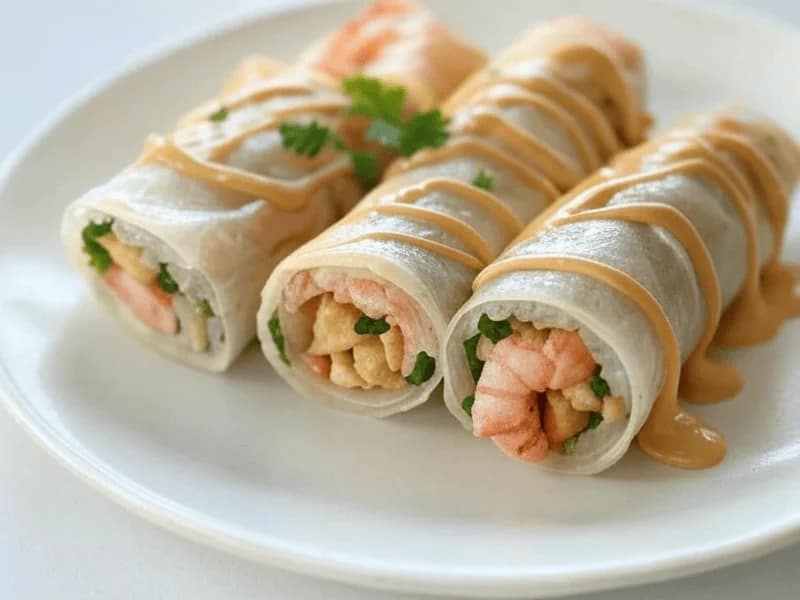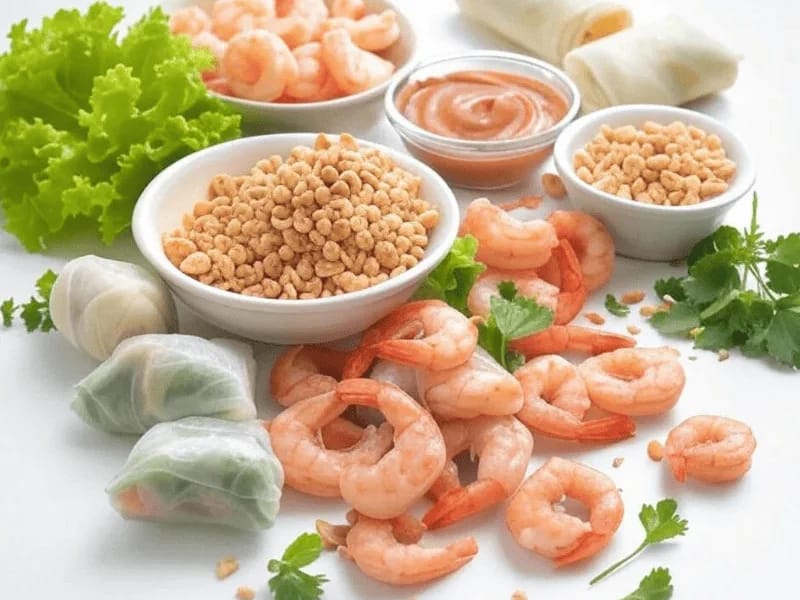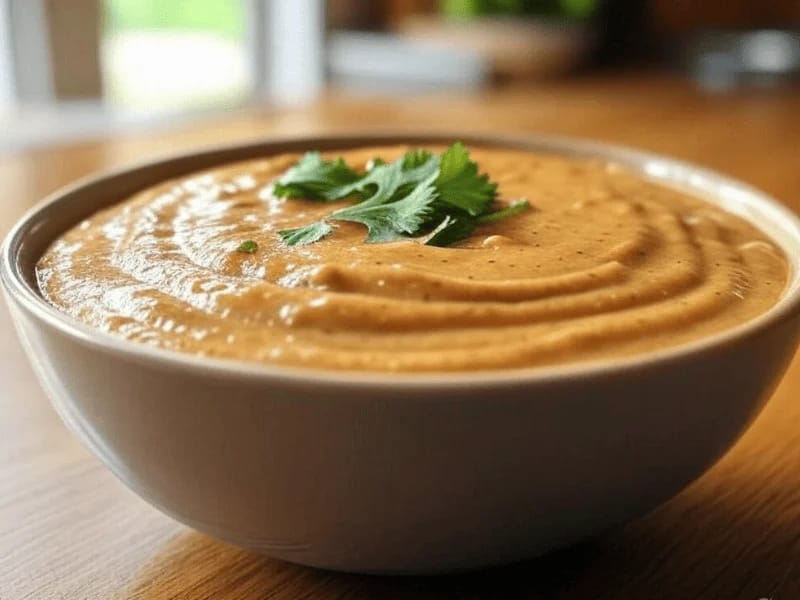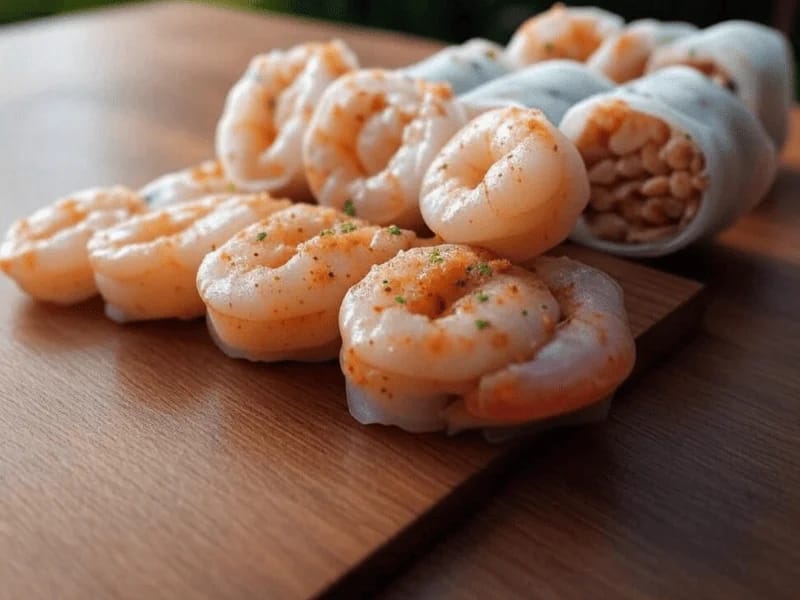Shrimp spring rolls are a pleasant, fresh, and tasty foretaste or snack, usually enjoyed across many beliefs, mostly in Southeast Asia. Known for their crunchy outer layer and energizing filling, these rolls are best for light snacks. Whether you assist them with a delicious dipping sauce or a spicy peanut sauce, shrimp spring rolls are a favorite of everyone.
In this article, we will take you through the whole thing you need to know about shrimp spring rolls: their history, components, making process, distinctions, and how to make them at home. You will also determine how easy it is to convert them to your taste and nutritional favorites, making them a multipurpose dish for any event. In this article, we’ll explore everything you need to know about shrimp spring rolls from their origins and ingredients to how they’re made and the different regional variations. Plus, if you’re curious about other light and healthy appetizers, check out our guide to the best Asian-inspired starters. You’ll also discover how easy it is to customize shrimp spring rolls to suit your taste and dietary needs, making them a versatile choice for any occasion.

What Are Shrimp Spring Rolls?
Shrimp spring rolls are covered in transparent rice paper, fresh veggies, and non-fried rolls. Unlike fried spring rolls, which are crusty all over, shrimp spring rolls have a soft and squishy, chewy outer layer, paired with an energizing and appetizing filling inside. The filling often consists of shrimp, fresh veggies, and herbs, and sometimes noodles, which are enfolded in the rice paper and served with a dipping sauce.
Shrimp spring rolls are mostly referred to as Vietnamese spring rolls in Western countries, though dissimilarities exist in diverse countries like Asia. They are healthy, light, and drown of exciting tastes. Unlike fried appetizers, they are filled with fresh elements, making them a healthier option, best for those looking to enjoy a delicious dish without the additional calories of frying.
History of Shrimp Spring Rolls
Spring rolls have been enjoyed for centuries, first appearing in ancient China as a traditional and flavorful dish. The shrimp spring rolls were usually made during the spring festival to rejoice in the harvest. The recipe gradually progressed and spread to other parts of Asia, where each region takes on the dish to start its own ingredients and cooking traditions.
Vietnamese spring rolls, known as Goi Cuon, are considered one of the most popular varieties. These fresh rolls typically contain shrimp, rice vermicelli noodles, lettuce, and herbs, covered in rice paper. The simple, tasty filling makes the dish perfect for summer, earning it the name “summer rolls” in many countries.
In Thailand, spring rolls are served fried, making a crunchy outer layer. Nevertheless, in Western countries, the trend has changed towards serving them fresh, as a lighter, better substitute. The usefulness and uplifting nature of shrimp spring rolls make them a popular choice among food fanatics worldwide.
Ingredients for Shrimp Spring Rolls In Home Kitchens
What makes shrimp spring rolls special is how flexible they are; you can easily mix and match ingredients to suit your taste. You can adjust the ingredients based on your preferences, making it easy to customize the rolls for different tastes and dietary needs. Here are the traditional components:
Shrimp:
The star of the dish. Shrimp is cooked (usually boiled or sautéed), peeled, and often sliced in half to make it easier to wrap. Choose fresh, good-quality shrimp to get the best flavor in every bite.
Rice Paper
Rice paper is what keeps everything neatly wrapped in a spring roll. It is super thin and a bit see-through. You’ll usually find it at most grocery stores, especially in the Asian foods section. Just marinate it in water for a few seconds, and it turns soft and stretchy, ready to roll up your fresh ingredients
Rice Vermicelli Noodles
These thin noodles add texture and bulk to the rolls. They are quick to cook and help bind the ingredients together, making each bite more filling.
Fresh Vegetables
- Lettuce: Romaine, butter lettuce, or iceberg lettuce are popular choices. The leaves provide a crisp and refreshing texture to balance out the shrimp.
- Carrots: Julienned carrots add a slight sweetness and crunch, making them a perfect complement to the savory shrimp.
- Cucumber: Sliced thinly, cucumber provides freshness and a crisp texture, balancing the other ingredients.
Herbs
Fresh herbs like mint, cilantro, and basil are commonly used in shrimp spring rolls for their aromatic qualities. These herbs uplift the flavor and odor of the rolls, making them more aromatic and mouthwatering.
Dipping Sauce
Shrimp spring rolls are served with a dipping sauce. Some popular options include:
- Peanut Sauce: Made with peanut butter, soy sauce, hoisin sauce, and garlic, this creamy and slightly sweet sauce pairs perfectly with the rolls.
- Nuoc Cham: A Vietnamese dipping sauce made from fish sauce, lime juice, sugar, and garlic, offering a tangy and savory contrast to the freshness of the rolls.

How to Make Shrimp Spring Rolls at Modern Kitchens
Making shrimp spring rolls is easy and can be done in just a few steps. The process may seem a bit intricate at first, but with practice, you’ll find it’s quite simple to prepare delicious spring rolls right at home. For step-by-step visuals and expert tips, check out this detailed spring roll tutorial that makes the process even easier to follow.
Step 1: Prepare the Shrimp
- If using frozen shrimp, thaw them by placing them in cold water for 10-15 minutes. You can also opt to cook them from frozen if you’re short on time.
- Boil the shrimp until they turn pink and opaque (usually 2-3 minutes). Once cooked, remove the shells and tails, and cut them in half lengthwise to make them easier to fit inside the rolls.
Step 2: Cook the Rice Noodles
- Bring a pot of water to a boil, add the rice vermicelli noodles, and cook them according to the package instructions (usually 3-5 minutes).
- Drain the noodles and rinse them under cold water to stop the cooking process. Set them aside in a bowl.
Step 3: Prepare the Vegetables and Herbs
- Wash and dry the lettuce, cilantro, mint, and basil leaves thoroughly.
- Peel the carrots and cucumber, then slice them into thin matchsticks or julienne strips. The thin cuts help make rolling easier and ensure that the vegetables fit well inside the rice paper.
Step 4: Soften the Rice Paper
- Fill a large bowl with warm water. One by one, dip each rice paper sheet into the water for about 5-10 seconds until softened. Avoid leaving the rice paper in the water for too long, as it can become too sticky to handle. Remove the sheet and place it flat on a clean, damp kitchen towel or cutting board.
Step 5: Assemble the Spring Rolls
- Once the rice paper is soft, gently place it flat on your work surface.
- Begin layering the ingredients. Begin by placing a lettuce leaf down first. Then add a small amount of noodles, a few shrimp slices, some thin strips of carrot and cucumber, and finish with a little fresh mint or cilantro
Step 6: Roll the Spring Rolls
- Fold in the sides of the rice paper and gently roll the wrapper from the bottom upwards, tightly but without tearing. Keep the roll compact to ensure that all the ingredients stay securely inside.
Step 7: Serve with Dipping Sauce
- Place the finished rolls on a serving plate, ensuring that they don’t touch each other to avoid sticking. Serve with your chosen dipping sauce, whether it’s peanut sauce or any other sauce.

Tips for Perfect Shrimp Spring Rolls In Beautiful Kitchens
- Do Not Stuff Too Much Inside: keeping it light makes wrapping easier and helps avoid tearing the rice paper. Keep the layers thin for a better rolling experience.
- Use Fresh Ingredients: The key to delicious shrimp spring rolls lies in the freshness of the ingredients. Fresh herbs, crisp vegetables, and tender shrimp will make your rolls flavorful and aromatic.
- Keep the Rice Paper Moist: If the rice paper starts to dry out while you’re assembling, it can become brittle. Cover it with a damp cloth so it stays soft and doesn’t dry out.
- Make Ahead: You can prepare the shrimp and veggies in advance, but it’s best to roll the spring rolls right before serving to avoid soggy wrappers. If you need to store them, wrap each roll in plastic wrap and keep them in the fridge for up to a day.
Variations of Shrimp Spring Rolls
While shrimp is a popular choice, you can easily switch it up with other proteins or even go vegetarian. Here are some variations:
- Chicken Spring Rolls: Replace shrimp with grilled or roasted chicken breast for a different flavor.
- Tofu Spring Rolls: For a vegetarian or vegan option, replace shrimp with firm tofu for a protein-packed roll.
- Pork Spring Rolls: Sliced grilled pork can make a savory and flavorful addition.
- Fruit Spring Rolls: For a sweet variation, you can add tropical fruits like mango, pineapple, or strawberries alongside the vegetables.

Conclusion
Shrimp spring rolls are not only delicious but also versatile, fresh, and healthy. They can be customized to suit your taste preferences, and they make an excellent addition to any meal, whether served as an appetizer or a light lunch. The best part is that they’re easy to make at home with just a few simple ingredients.
Whether you’re making them for a family dinner, a casual gathering, or even meal prep, shrimp spring rolls are sure to impress. Their light, refreshing flavor, combined with the satisfying crunch of the fresh vegetables and herbs, makes them a perfect choice for any occasion. Try making shrimp spring rolls at home, and experience the joy of preparing a dish that’s both healthy and mouthwatering!
